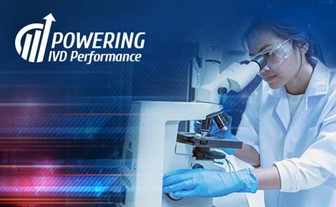Most activities in biological research could not be done easily, if at all, without the use of one or more bioconjugate reagents to assay, detect, track, image or capture target molecules or effectively target and treat diseases.1

Bioconjugation is a critical skill that can be used for a range of applications, including immunnoassays. It has aided the discovery of new biomolecules, the elucidation of complex biological processes and the spawning of entire industries within the field of medical diagnostics.1
In this short blog post, we will discuss the various bioconjugation techniques currently available for immunoassays and highlight the importance of bioconjugation for the development of diagnostic immunoassays.
The Importance of Bioconjugations in Successful Immunodiagnostics
In its most fundamental aspect, bioconjugation simply involves the attachment of one molecule to another, usually through a covalent bond, to create a complex consisting of both molecules together.1
Bioconjugation is a process that couples two biomolecules together in a covalent linkage. Different strategies may be applied to produce successful bioconjugates, however, selecting the optimal conditions for bioconjugates can impact the success of an immunoassay.
Figure 1. Common bioconjugation strategies used in immunoassays1

Types of bioconjugates that are made by linking two or more molecules together include a) streptavidin-enzyme conjugate, b) immobilised affinity ligand on a particle, d) fluorescently labelled streptavidin, e) an affinity ligand attached to a surface, f) a biotinylated enzyme, h) a fluorescently labelled antibody, i) a biotinylated antibody.
We have a comprehensive portfolio of labelling molecules which can be used to create bioconjugates to support a range of immunodiagnostic assays.
Development of a Highly Active, Novel Recombinant Alkaline Phosphatase
SEKISUI Diagnostics have developed the Smartbond alkaline phosphatase, a novel recombinant alkaline phosphatase (AP) as an alternative to bovine enzymes, for use in immunoassays such as enzyme-linked immunosorbent assay (ELISA) and chemiluminescent immunoassays. An important attribute is the presence of an affinity tag allowing the generation of highly-purified enzymes, while the fact that it is a recombinant product from a bacterial gene – unlike the native classical bovine enzyme – means it overcomes regulatory challenges relating to the declaration of animal-derived products in reagent kits.
Learn more about the benefits of a novel bacterial AP alternative for use in immunoassays and how to optimise the conjugation for possible use in our webinar.
Figure 2. The conjugation of SEKISUI Diagnostics’ recombinant AP to a model monoclonal antibody using amine chemistry2

SEKISUI Diagnostics conjugation protocol: We have used molecules based on amine chemistry to link molecules firstly to the AP and then the biomolecule of interest, the antibody (left). These were then conjugated to form the molecule on the right.
Our novel Smartbond alkaline phosphatase has been developed to support in vitro immune-detection methods such as ELISA.
Additional benefits of our novel AP include:
- High specificity
- Potential for developing highly-sensitive diagnostic test methods
- Reported to be superior to bovine intestinal AP in ELISA tests
- Good reactivity with commonly-used substrates including chromogenic (pNPP), fluorogenic (4-MUP) and chemiluminescent (AMPPD, CDP-Star and CSPD) substrates
Figure 3. A novel recombinant AP specific activity: comparison to different suppliers/types of AP2

SEKISUI Diagnostics’ portfolio of Smartbond molecules are appropriate for a wide range of immunoassay applications. Our specialised streptavidin, for instance, helps optimise robust and highly sensitive assays:
- Smartbond streptavidin which has a core streptavidin, a proven molecule with the highest binding affinity towards biotin
- Smartbond streptavidin magnetic beads, where Smartbond streptavidin is covalently coupled to paramagnetic beads via proprietary linkers, producing beads that possess the highest biotin-binding capacity in the market
Table 1. SEKISUI Diagnostics’ streptavidin conjugates offer strong binding, high activity and high purity
|
|
Bioconjugation method |
Biotin bonding |
Applications |
|
Smartbond streptavidin |
Core streptavidin, a proven molecule with the highest binding affinity towards biotin |
High specific activity providing greater binding capacity to biotin per mg of protein |
magnetic bead-based immunoassay applications |
|
Smartbond streptavidin magnetic beads |
Covalently coupled to the paramagnetic bead via proprietary linkers |
Highest biotin binding; outperforms competitors on free-biotin binding capacity |
Optimised and validated for use with high-throughput random access magnetic platform analysers in the application of immunodiagnostics |
SEKISUI Diagnostics has developed specialised streptavidin for the enhancement of signal generation and a highly-active novel bacterial AP as a labelling enzyme suitable for a wide range of immunoassay applications.
Our Ready-to-Use Conjugation Protocols Have Been Designed to Help Research Scientists Save Time and Resources
We understand how time-intensive laboratory research can be, which is why we’ve developed ready-to-use protocols for conjugating Smartbond streptavidin to horseradish peroxidase (HRP) and conjugating Smartbond alkaline phosphatase – giving you more time and resources to dedicate to your immunoassays.
The SEKISUI Diagnostics advantage offers multiple benefits for researchers
Our mission is to provide intelligent solutions to enhance life with science.
Choose SEKISUI Diagnostics and Benefit from the Advantages of Working With Us as Your Trusted Partner
- Enzymes that have been supporting major players in the global in vitro diagnostic (IVD) industry for decades
- A focused portfolio of enzymes and ancillary materials specifically targeted for IVD applications
- Manufacturing expertise and fully integrated R&D, quality and engineering and a long-established supply chain
Learn how SEKISUI Diagnostics can support your research and development needs
References:
- Hermanson GT. Bioconjugate techniques. Third edition. Available at https://www.google.co.uk/books/edition/Bioconjugate_Techniques/6aO-207lhdgC?hl=en&gbpv=1 (Accessed November 2021).
- Pushing the Boundaries of Immunoassay Performance: Optimising the Conjugation of a Novel Alkaline Phosphatase. Available at: https://sekisuidiagnostics.com/support/webinars/watch-novel-recombinant-alkaline-phosphatase-webinar/ (Accessed November 2021).
- Sekisui Diagnostics. About us. Available at: https://sekisuidiagnostics.com/about-us/ (Accessed November 2021).



Share Article